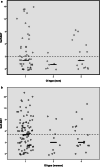Bleeding assessment in a large cohort of patients with Osteogenesis Imperfecta
- PMID: 38347577
- PMCID: PMC10860322
- DOI: 10.1186/s13023-024-03054-8
Bleeding assessment in a large cohort of patients with Osteogenesis Imperfecta
Abstract
Background: Osteogenesis Imperfecta (OI) is characterised by bone fragility. Among several features, easy bruising and multiple case reports on haemorrhagic events have been reported. This paper describes the diverse manifestations of bleeding and bruising in a large cohort of 328 OI patients. The aim of this study is to provide insight in the diverse aspects and therapeutic considerations of bleedings in OI.
Methods: This descriptive cohort study was conducted at the National Expert Center for adults with OI in the Netherlands. Bleeding was assessed by the validated self-bleeding assessment tool (Self-BAT) The tool was distributed among 328 adults with different clinically confirmed types of OI.
Results: 195 of 328 invited patients (completion rate 60%) with OI type 1 (n = 144), OI type 3 (n = 17) and OI type 4 (n = 34), aged between 18 and 82 years, completed the tool. Self-BAT scores were above the normal range in 42% of all patients. For males Self-BAT scores were increased in 37% with a mean score of 3.7, ranged between 0 and 18. For females the Self-BAT scores were increased in 44% with a mean of 5.4 and a range of 0-24. No statistical differences in OI subtypes were found.
Conclusions: Bleeding tendency appears to be a relevant complication in OI patients as this study confirms the presumption of bleeding tendency. There are specific recommendations to clinicians who treat OI patients to consider an assessment of bleeding tendency and use potential interventions to reduce haemorrhagic complications and improve quality of life.
Keywords: Bleeding disorders; Haemorrhage; Hematoma; Osteogenesis Imperfecta; Self-BAT; Vessel fragility.
© 2024. The Author(s).
Conflict of interest statement
The authors declare no competing interests.
Figures
References
-
- Steiner R, Adsit J, Basel D. COL1A1/2-Related Osteogenesis Imperfecta. GeneReviews. doi:NBK1295 [bookaccession]
-
- Gooijer K, Rondeel JMM, van Dijk FS, Harsevoort AGJ, Janus GJM, Franken AAM. Bleeding and bruising in Osteogenesis Imperfecta: International Society on Thrombosis and Haemostasis bleeding assessment tool and haemostasis laboratory assessment in 22 individuals. Br J Haematol. 2019 doi: 10.1111/bjh.16097. - DOI - PubMed
MeSH terms
LinkOut - more resources
Full Text Sources
Medical



